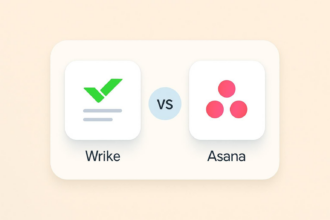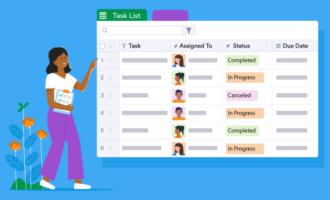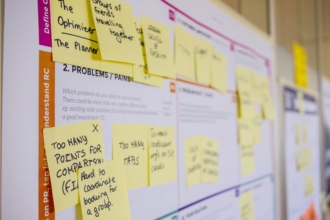Top 10 task management tips
- Automate repetitive tasks
- Assign one owner to each task
- Visualize your workflow
- Set SMART goals
- Prepare a to-do list
- Focus on transparent communication
- Set realistic deadlines
- Review and adjust daily
- Minimize context switching
- Use a task management tool
Our productivity is under attack. The assailant is repetitive tasks that don’t require critical thinking or creativity. In fact, more than 36 percent of workers say they spend a minimum of one full day on tedious tasks like gathering information about the status of a project.
These five task management tips will help you and your team combat repetitive tasks and take your entire workflow to the next level.
Why is task management important?
Effective task management is crucial for maintaining productivity, meeting deadlines, and ensuring smooth collaboration. It helps teams allocate resources efficiently, prioritize high-impact tasks, and reduce stress caused by missed deadlines or miscommunication.
Businesses can optimize workflows, minimize wasted time, and enhance team performance by implementing a structured task management approach. Additionally, well-managed tasks lead to better accountability, increased efficiency, and successful project outcomes.
10 tips to boost efficiency and productivity
We’ve selected our top five task management tips that go a long way in transforming work processes and productivity so you can ultimately check more boxes on your to-do list.
1. Automate repetitive tasks
Repetitive tasks like data entry, status updates, and report generation can take up valuable time and reduce efficiency. By automating these tasks, teams can focus on higher-priority work while minimizing errors.
Most digital task management tools include built-in automation features that allow teams to streamline workflows. For example
- Automated reminders: Set up task deadlines with automatic notifications to keep everyone on track.
- Data synchronization: Connect apps like Jotform with Google Sheets, Slack, or project management tools to automatically capture and update information.
- Recurring tasks: Schedule repetitive tasks (e.g., weekly reports or monthly audits) to auto-generate at set intervals.
2. Assign one owner to each task
Clearly defining task ownership eliminates confusion and keeps workflows efficient. If more than one person is responsible for a task, accountability can become unclear, leading to delays and miscommunication.
- Ensure clear responsibility: Assign each task to a single owner so it’s clear who is accountable for its completion.
- Reduce workflow disruptions: A dedicated task owner makes decisions and moves the task forward without unnecessary back-and-forth discussions.
- Encourage proactive updates: The task owner should provide status reports and flag any potential roadblocks before they cause delays.
3. Visualize your workflow
A clear visual representation of the workflow helps teams track progress, identify bottlenecks, and maintain efficiency. Instead of relying on constant status check-ins, teams can simply refer to a shared task board for updates.
- Use kanban boards: Visualize tasks with columns like To Do, In Progress, Review, and Completed to track progress at a glance.
- Identify recurring bottlenecks: Spot where tasks frequently get stuck and adjust processes to prevent slowdowns.
- Improve collaboration: Ensure transparency by making workflows visible to everyone involved.
- Refine workflow strategies: Regularly review and optimize task flows to remove unnecessary steps and improve efficiency.
4. Set SMART goals
Setting SMART (Specific, Measurable, Achievable, Relevant, and Time-bound) goals is essential for effective task management. This structured approach ensures tasks are well-defined, achievable, and aligned with broader objectives.
- Specific: Clearly outline what needs to be done. Instead of “Improve team communication,” set a goal like “Hold a weekly 30-minute team meeting to review progress and address concerns.”
- Measurable: Define success metrics. For instance, “Complete 90% of assigned tasks within deadlines for the next three months.”
- Achievable: Set realistic expectations based on available resources and constraints.
- Relevant: Ensure the goal aligns with team priorities and business objectives.
- Time-bound: Assign a deadline, such as “Develop a new onboarding checklist for new employees by the end of the quarter.”
Using SMART goals helps team members stay focused, measure progress effectively, and adjust strategies when needed.
5. Prepare a to-do list
A structured to-do list is essential for prioritizing tasks, avoiding confusion, and ensuring nothing is overlooked. To maximize effectiveness:
- Break down tasks: Instead of listing broad objectives, break them into actionable steps. For example, instead of “Launch a marketing campaign,” list subtasks like “Draft email templates,” “Schedule social media posts,” and “Analyze engagement metrics.”
- Use prioritization techniques: Apply methods like the Eisenhower Matrix (urgent vs. important) or ABCD prioritization (A = critical, B = important, C = optional, D = delegate).
- Leverage digital tools: Task management software tools like Jotform, Trello, Asana, and ClickUp enable real-time updates, collaboration, and progress tracking.
- Review and update regularly: A to-do list should be dynamic — revisit it daily to check off completed tasks and reassign priorities if necessary.
6. Focus on transparent communication
Clear and open communication ensures everyone understands their responsibilities and stays aligned with team goals. Poor communication can lead to misunderstandings, missed deadlines, and duplicated efforts.
- Choose the right communication channel: Use Slack or Microsoft Teams for quick updates, email for formal discussions, and video calls for in-depth conversations.
- Document tasks and decisions: Record project progress, meeting notes, and action items in shared platforms like Google Docs, Notion, or Confluence.
- Encourage feedback loops: Regularly check in with team members to clarify expectations and address any roadblocks.
A culture of transparency ensures everyone is on the same page, leading to increased trust, collaboration, and efficiency.
7. Set realistic deadlines
Overly ambitious deadlines can lead to burnout, rushed work, and decreased productivity. Instead, set achievable deadlines by:
- Assessing task complexity: Break large projects into smaller, manageable milestones with deadlines for each phase.
- Factoring in buffer time: Allow extra time for unexpected challenges, revisions, or dependencies on other tasks.
- Avoiding multitasking overload: Encourage team members to focus on priority tasks rather than juggling multiple deadlines at once.
- Regularly reviewing workloads: If a deadline feels unrealistic, communicate early and adjust expectations accordingly.
Setting realistic and well-planned deadlines allows teams to work efficiently, reduce stress, and deliver high-quality results without last-minute chaos.
8. Review and adjust daily
Task management isn’t a set-it-and-forget-it process — it requires continuous monitoring and adaptation to ensure efficiency and success. A daily review helps teams stay on track by:
- Checking progress: Assess which tasks are completed, in progress, or delayed.
- Identifying roadblocks: Determine what’s causing delays (e.g., unclear instructions, resource limitations) and address issues proactively.
- Reprioritizing tasks: If urgent tasks arise, adjust the day’s plan accordingly without disrupting overall project timelines.
- Encouraging accountability: A quick end-of-day or start-of-day team check-in can help maintain focus and accountability.
Using a daily review process ensures teams remain agile and can quickly adapt to new priorities or challenges.
9. Minimize context switching
Switching between multiple tasks, tools, and conversations throughout the day reduces focus and productivity. Minimizing context switching helps teams stay efficient and engaged.
- Group similar tasks: Batch tasks that require similar skills or focus to reduce cognitive load.
- Limit active projects: Encourage team members to focus on completing one task before moving on to another.
- Use integrations to consolidate tools: Integrating task management, communication, and file-sharing tools reduces the need to switch between multiple platforms.
- Schedule deep work sessions: Block out time for uninterrupted work to prevent distractions and increase efficiency.
10. Use a task management tool
Task management tools help teams stay organized, streamline workflows, and improve collaboration. However, simply having a tool isn’t enough — it must be used strategically to maximize efficiency.
- Choose the right tool for your team: Select a platform that fits your workflow. Jotform Tables allows teams to cross-functionally manage day-to-day tasks by collecting, organizing, and managing data in an all-in-one workspace. Tables organize different tasks and enable teams to assign owners, communicate with one another, automate repetitive tasks, and much more.
- Standardize task creation: To prevent ambiguity, ensure every task includes a clear title, description, priority level, due date, and assigned owner.
- Leverage built-in automation: Use recurring task scheduling, status updates, and automatic reminders to reduce manual work and improve consistency.
- Encourage team-wide adoption: Train team members on best practices and ensure they consistently update tasks to keep workflows transparent.
Using a task management tool effectively ensures that work stays on track, collaboration remains smooth, and productivity improves across the team.
Prioritizing task management for business growth
When your task management processes improve, your team’s productivity increases, and your business scales.
Suppose you’re working to automate repetitive tasks, assign tasks to single owners, visualize your workflow, implement project management methodologies, and stay in one software solution. In that case, you can level up your task management practices for better results.























Send Comment:
1 Comments:
More than a year ago
Appreciate it, Thanks for sharing.